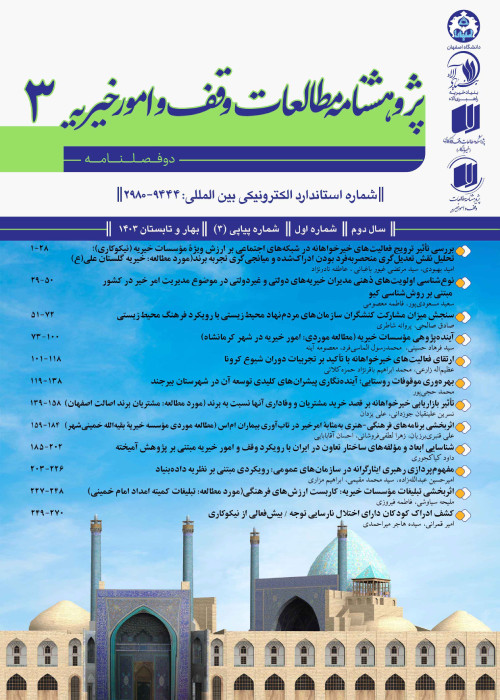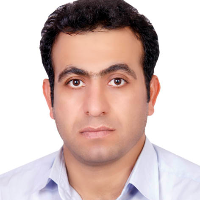Endowment governance and production of urban spaces in Kermanshah
The expansion of urbanization in Kermanshah and the issue of endowment as phenomena that can partially clarify the different experiences of Kermanshah in its development is an issue that has not been discussed so far. Endowment has had important characteristics and functions, the most important of which are: not being class-based, creating a sense of social solidarity and even in moments of history, being a mechanism to realize social justice and participating in the social security system, and poverty alleviation. The production of urban space in the city of Kermanshah is at least influenced by two historical factors, one of which is rooted in the religious political economy and the other in the modern capitalist political economy. This article is going to discuss the role the endowment institution has played in the production of modern urban spaces in Kermanshah. Besides, this article is going to know how the endowment mechanism that affects the production of the urban space of Kermanshah, is elaborated in different political orders.
Theoretically, Lefebvre's theory of space production has been used, emphasizing the moment of spatial representations, as well as Gertsel's theory of political order. In terms of methodology, this research is affected by the dialectic of regressive-progressive: "The point of view adopted here may be described as regressive-progressive." This method places the facts of the present as the starting point. This means that referring to anything in the past is rooted in the issues of the present. Looking from the point of view of the present causes a search in the past. It is what determines at which moment in history the researcher should search for the origin. This attitude is also a kind of genealogy.
In the pre-constitutional political order, the endowment governance was in crisis only when the governments used the endowment revenues to gain territory. Otherwise, an agreement between the institution of religion and the patriarchal system was gradually made regarding its governance, and it was generally governed in a bureaucratic manner. Although it was not always the institution of religion or specifically the class of scholars and Ulama who only benefited from its income or its supervision, they were involved in the endowment institution in different ways (Shafaghi, 2016). This crisis entered a new stage with Reza Shah's modernization approach."Reza Shah’s official nationalism was largely based on the manipulation of this patriotism and a program of cultural assimilation and coercive linguistic unification" (Matin, 2013: 85). The nationalist order predominance in the political system of the Pahlaviera changed the governance of endowment. These developments became actual with modernization. Urbanization based on infrastructure construction for capital circulation, so that urban spaces should be produced in such a way that new consumer goods could be traded, was generally the central core of the nationalist order of this era. Nationalistic assimilation and identification were in line with the same standardization that capitalism needed for its globalization. Kermanshah was also not immune from these developments. The end of this order had unintended consequences that were inseparable from the evolution of the endowment governance in this city. Reza Shah did this to enrich the royal family and consequently the power of his central government. He declared that many estates and lands in the most fertile areas of the country belong to the state or are monarchical.
In the pre-modern political order, which in a sense can also be called a religious order, the endowment system was such that it could perform a complex function in the long-term division of labor and in which this institution could continue its life under the legitimacy of religion. In that order, the endowment was a public institution that was able to shape the economic metabolism and by that, the economic matter was embedded in the social life. The city of Kermanshah and its spatial development in the Nasrid era clearly shows the decisive influence of endowment. It shows how the community character of the endowment has organized power and wealth relations in the community and, by extension, the city as a whole. The most important result of the endowment functions in this era was the relative generalization of wealth. In the nationalist order of the era of Reza Shah and Mohammad Reza Shah, endowment became an organization under the modern state bureaucracy, and the process of de-personalization of endowment, which is the other side of the coin of community decentralization, began. At the same time, the income from the properties and endowments should mainly be spent on the things that the government recognizes. After the 1979 revolution, efforts have been made to revive the regulatory role of religion, but it has not led to the possibility of returning to the pre-modern religious order. Therefore, the charitable function of endowment becomes more prominent in the new order. This is the result of the relationship between the changes in the endowment organization and the new political order. This new order, which took control after the 8-year war, was the neoliberal order. The three basic principles of the neoliberal order are deregulation, structural adjustment, and privatization, according to which the public expenses of the government should be reduced. In addition to this cost reduction, which takes place under structural adjustment, public expenses should be outsourced in the form of charity affairs. This is where the prominence of charity affairs in the endowment organization becomes important and prominent. In addition, during this period, the endowment organization sought to stabilize its position by judicially dealing with the status of endowment properties, which were undecided half a century ago and their fate has changed.
- حق عضویت دریافتی صرف حمایت از نشریات عضو و نگهداری، تکمیل و توسعه مگیران میشود.
- پرداخت حق اشتراک و دانلود مقالات اجازه بازنشر آن در سایر رسانههای چاپی و دیجیتال را به کاربر نمیدهد.



